Category: Deer Hunting
Learning New Whitetail Hunting and Management Techniques
While in college, I was taught about the circle principle. Simply stated, the principle is that our knowledge base is like a circle. As the circumference of a circle increases, the border of the circle gets bigger. Likewise, the more we know, the more we realize we don’t know. I’ve been a practicing wildlife biologist for 20+ years. My firm, Woods and Associates, Inc. was incorporated during 1990. Throughout this time, I’ve worked primarily with white-tailed deer and turkey throughout their ranges. Even with this level of experience and opportunities to learn, I have more questions now than when I started and my desire to learn is probably at an all time high.
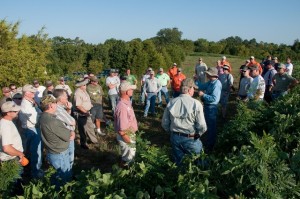 Because I’m now a husband, dad, etc., I have less time I can dedicate to learning, research, etc. That’s why I really enjoy learning from others that share my passion for hunting, wildlife, and habitat management. One of the best ways to meet such folks is at events such as the Land and Wildlife Expo to be held in Nashville, TN during August 12th – 14th. There will be speakers talking about the many aspects of deer management and current topics such as predation. There will also be field demonstrations and the ability to visit directly with manufacturers. This is a great chance to ask wildlife managers and folks from the hunting industry direct questions face to face.
Because I’m now a husband, dad, etc., I have less time I can dedicate to learning, research, etc. That’s why I really enjoy learning from others that share my passion for hunting, wildlife, and habitat management. One of the best ways to meet such folks is at events such as the Land and Wildlife Expo to be held in Nashville, TN during August 12th – 14th. There will be speakers talking about the many aspects of deer management and current topics such as predation. There will also be field demonstrations and the ability to visit directly with manufacturers. This is a great chance to ask wildlife managers and folks from the hunting industry direct questions face to face.
I look forward to learning and hopefully sharing information with fellow hunters and wildlife managers. If you plan to attend, let me know. Several of the GrowingDeer.tv gang are talking about planning a time we can visit about our personal hunting and management plans for this fall. I plan on learning and preparing to be a better hunter this fall. I hope we can visit there.
Growing Deer together,
Grant
Fight Target Panic with Bow Practice
 I’ve shot a bow since early childhood. Even with that level of experience (I’m now 50), I still go through seasons of struggling with shooting accurately. Archery is a very mental sport and no one stays on top of their game every day (or season). In my last blog, bow practice, I discussed the “perfect practice makes perfect” principle as applied to shooting a bow. This week, I’d like to share an archery practice technique called blind bale. It is really a different form of “perfect practice makes perfect.” It is simply practicing with your bow at a target that is only three feet or so down range. In addition, the shooter has his eyes closed throughout the shot. This is done so the shooter can totally concentrate on form and not aiming at a spot.
I’ve shot a bow since early childhood. Even with that level of experience (I’m now 50), I still go through seasons of struggling with shooting accurately. Archery is a very mental sport and no one stays on top of their game every day (or season). In my last blog, bow practice, I discussed the “perfect practice makes perfect” principle as applied to shooting a bow. This week, I’d like to share an archery practice technique called blind bale. It is really a different form of “perfect practice makes perfect.” It is simply practicing with your bow at a target that is only three feet or so down range. In addition, the shooter has his eyes closed throughout the shot. This is done so the shooter can totally concentrate on form and not aiming at a spot.
I started this technique while suffering through a bad case of target panic. When my sight pen would come close to the spot I was aiming, I wouldn’t be able to trigger a release with my eyes open. If you’ve never experienced target panic, you can’t understand, and if you have, you share my grief! A friend of mine, CJ Davis, shared the blind bale technique with me. I thought it sounded silly and continued flinging arrows and flinching. Most shots failed to hit close to where I was aiming.
Out of desperation, I tried the blind bale technique. I shot at a target placed a few feet in front of me for a week. I shot for a week without looking at a spot. I simply shut my eyes and totally focused on my shooting form. During week two, I took 10 shots blind bale and then shot at a pie plate at 10 yards with no markings on it – just a white 9” target. I was amazed at the end of two weeks how well I shot. I was able to group as good as any time during my archery career.
Since them, I usually begin each archery practice session by shooting 10 or so shots using the bind bale technique. At times, I’ve forgotten the lessons I’ve learned and simply began flinging arrows. The size of my groups increase and I remember the huge advantages of reinforcing correct form and starting each practice session with the blind bale technique.
This technique will not benefit everyone as they may have a different problem such as shooting a bow that’s draw weight or length is not appropriate for them. However, if your shooting problems are not the result of equipment that is not tuned or equipment that is mismatched to you, then incorporating the blind bale technique into your practice will probably result in tighter groups at all distances.
Growing Deer together,
Grant
Bow Practice
I really enjoy shooting a bow. However, like most hunters I’m busy with family, work, etc, and my time to simply fling arrows is limited. Therefore I need to make my practice time as effective as possible. Over the years, I’ve learned some lessons that have definitively helped me be a better archer. These include the principle that “perfect practice makes perfect.”
Several years ago I practiced and hunted exclusively with a Black Widow recurve. In fact, the best buck I’ve harvested with a bow was shot with one of my Black Widows! I had shot a recurve on and off since childhood. However, in hindsight, I realized I had simply been flinging arrows. I attended an instinctive shooting clinic hosted by Black Widow and the instructor, Fred Asbell, taught that “perfect practice makes perfect.”
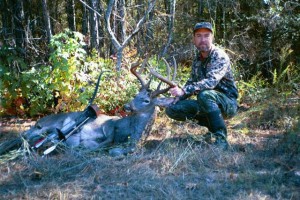 The jest of this principle is that we all learn by memorization – either mental or physical (muscle memory). So, if we simply fling arrows, we may not come to a complete draw, shut our eyes, release improperly, etc. We will be much better archers if we focus on our technique on each shot. If we do that, our muscles will remember the form and it will automatically occur when we don’t have time to go over our mental check list – like when aiming at a mature buck.
The jest of this principle is that we all learn by memorization – either mental or physical (muscle memory). So, if we simply fling arrows, we may not come to a complete draw, shut our eyes, release improperly, etc. We will be much better archers if we focus on our technique on each shot. If we do that, our muscles will remember the form and it will automatically occur when we don’t have time to go over our mental check list – like when aiming at a mature buck.
Since then, I’ve tried to slow down and make each shot count. I’m not a perfect archer, but I’m probably as good as my schedule allows. If you have limited time to shoot your bow, try incorporating the “perfect practice makes perfect” principle into your practice sessions. You will probably fling a few less arrows, but more will be where you are aiming – especially when the target has a lot of bone on its head.
In my next blog, I’ll share another technique that has helped me be a much better shot with a bow. In fact, it helped me resolve some problems I had with target panic.
Growing Deer together,
Grant
Cheap Deer Hunting Land
Most hunters I know talk about finding cheap land for deer and turkey hunting! I do also. There is a way that many can gain acreage for literally a few hundred dollars per acre and some sweat equity! It is as simple as controlling noxious, invasive weeds.
Webster’s dictionary defines a weed as: a plant that is not valued where it is growing and is usually of vigorous growth; especially: one that tends to overgrow or choke out more desirable plants. Most hunters can only afford or have access to hunt land that is less than desirable. If weeds are taking up space on your hunting property, then it is much less expensive to kill those weeds and improve the habitat than to purchase additional acres!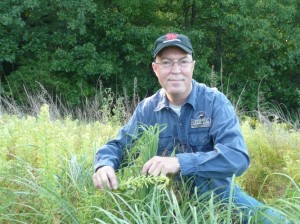
Weeds that are common and very invasive throughout most of the whitetail’s range include:
- Sericea lespedeza
- Johnsongrass
- Honey locust trees
- Knapweed
- Kudzu
There are many more species of invasive weeds that rob literally millions of acres of productivity from wildlife habitat.
The good news is that most of these weeds can be controlled by using a selective herbicide. A selective herbicide is one that only kills specific species. With some research, usually a herbicide that will kill the targeted weeds and not harm the beneficial species can be found. Although this research may seem daunting, I frequently use Crop Data Management Systems free website to research which herbicides to use for specific weeds.
The site can be searched by simply going to the Services and then Labels tabs. Then use simple search for the name of the herbicide to research, or use the advanced search option and search on specific herbicides and the crop you wish to protect.
For example, sericea lespedeza has invaded some of the bedding and native vegetation areas at The Proving Grounds. It doesn’t provide quality forage or cover for wildlife. It is literally decreasing the functional size of my hunting property. Some quick research pointed toward the herbicide PastureGard. However, I wanted specific information to know if PastureGard would control serecia lespedeza and if so, how to apply the herbicide. I searched the CDMS website for the PastureGard label and quickly confirmed it was a good choice to kill serecia lespedeza, how much herbicide to apply, and any personal safety precautions. The image at the top of this blog was taken this morning. I’m thrilled to see the serecia dying and the sparse big bluestem undamaged by the herbicide. I had confidence that would happen after reading the herbicide label.
Controlling weeds is a very important part of wildlife habitat management. Using the correct herbicide, if that’s the best method, saves the manager money and time and returns acres to productive habitat. I’m all about getting more hunting land for not much money and some sweat equity.
Growing Deer together,
Grant
Creating Hidey Holes
Brad, Hunter, Nathan, and I scouted some areas for new Hidey Hole food plots today. Hidey Hole plots are small plots that are usually less than an 1/8th of an acre in size. I usually create them by using hand tools – no tractors or mechanical equipment. The ideal location for a Hidey Hole plot is an area where:
- Deer frequent
- Hunters can access without being detected by deer
- Wind direction usually remains constant (like a ridge top)
- It helps if no large trees need to be removed
We like to locate these areas this time of year to limit disturbance to the deer herd closer to season. In addition, we begin killing brush, etc., now with a herbicide so when we remove saplings they don’t sprout back. We kill any grass or broadleaf weeds with a herbicide so they will dry up before planting season.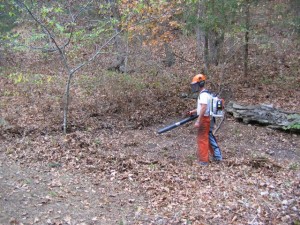
Just before planting the forage crop, I add ample fertilizer to help the forage crop grow rapidly and taste palatable to deer. For example, one 50 pound bag of 19 19 19 fertilizer applied to 1/8th acre is equivalent to applying 76 pounds of N, P, and K (400 pounds of 19 19 19) per acre. That’s usually enough to get a forage crop like wheat up and tasty for a month or two of great forage production. I plant the crop roughly three weeks before I anticipate hunting or the first frost. I also hang my Muddy stands and secure my Muddy SafeLine well before hunting season.
I try to avoid the area from when I plant until I hunt to allow deer to become conditioned to feeding in the area without being alert to two-legged predators. This is a critical step in creating a successful Hidey Hole food plot. In addition, I only hunt this location when the wind direction is appropriate. I don’t waste the effort spent creating the hotspot by allowing the local deer to associate the spot with human (predator) activity.
This is a great technique to see and harvest mature bucks that can be used on properties from ten to 1,000 acres. Hidey Hole food plots are not designed to increase the quantity of nutritious forage in an area, but to allow hunters to observe and harvest mature bucks at close range by providing high quality forage with minimal equipment and expense. Hidey Holes are a great tool to harvest mature bucks.
Growing Deer together,
Grant
Using Color to Predict Antler Growth Potential
In a blog entry earlier this week, Using Maps To Plan Where to Hunt this Fall, I shared a source of data from the NOAA in the form of a map that predicted precipitation or the lack of for the next few weeks in the Lower 48. Precipitation levels can be correlated with forage production and quality. Too much or too little precipitation can limit plants ability to transfer nutrients from the soil to deer.
Deer require high quality nutrition on a year round basis to express their full antler growth or fawn production potential. I doubt many free-ranging, wild deer express their full potential. The stress of avoiding predators, lack of quality forage, parasites, diseases, injuries, etc., all reduce a deer’s ability to express their full potential. Of these, it’s easiest for hunters to predict the quality of forage available when planning where to hunt during the upcoming season.
This time of year many whitetail and elk hunters are applying for tags in states where they are not residents. If antler potential is a factor of where you are deciding to hunt, I encourage you to study the following map based on NOAA data.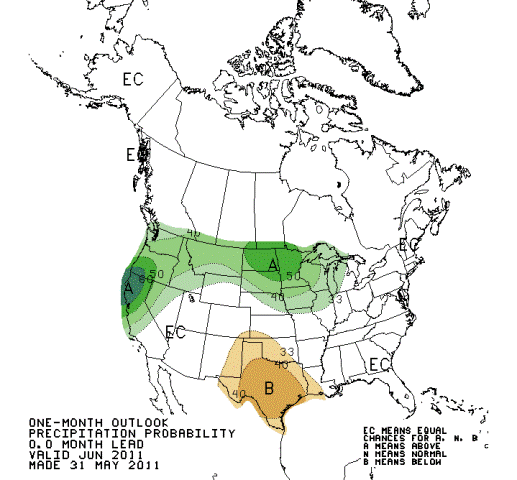
Precipitation amounts during spring green-up are critical to the antler development that year. Many forage plants (native and cultivated) are highest in digestible nutrients during the spring. If too much or not enough precipitation occurs during this time of year, the quality of forage and therefore quality of antlers can be reduced.
This is critical data to consider if you are planning an out of state hunt with the goal of harvesting a buck that has expressed a high percentage of his antler growth potential.
Based on the following map, most of west Texas, Oklahoma, and southwestern Kansas received way less than normal precipitation during the critical spring green-up period this year. Most of the Ohio River Valley and southern Missouri and Northern Arkansas received way more precipitation than normal during this same period of time. I suspect antler development will be less than average in both of these areas.
Much of the Midwestern corn belt received about the normal amount of precipitation during the same period of time. If this pattern continues throughout the summer, antler development should progress well in these areas.
Most of us have limited time and funds for hunting. By using the data from the map in this and the previous blog, those limited hunting days can be spent in areas where antler development may be the best this fall. Maps are one of the most useful scouting tools!
Growing Deer together,
Grant
Using Maps To Plan Where to Hunt this Fall
There has been much written about using maps to locate stand locations. I use topo maps, aerial images, etc., to learn the lay of the land, especially when hunting a new area. However, I study the NOAA Drought Indicator maps to plan which state or region to go hunting and to assist me with planning food plot strategies for both fall and spring.

NOAA’s drought indicator maps are available online and for free. They are maps that predict the amount of precipitation or lack thereof for the lower 48 states. It’s obvious why predictions of precipitation amounts are important for planting crops. It may not be obvious why I use them to plan where to hunt.
I’m not using them to plan where to hunt based on the chance of getting rained out! Those predictions are rarely accurate. Meteorologists rarely can predict precipitation three days out let alone three months out with accuracy. However, they are much better at studying ocean temperatures, currents, etc., and predicting general amounts of precipitation a region will receive. Precipitation is a key determinant of antler production.
You may recall that I frequently state in blogs and in episodes that plants are simply nutrient transfer agents. They can’t transfer nutrients to deer if the nutrients aren’t in the soil. If not enough precipitation occurs, the plants can’t use the available nutrients. Most folks associate drought conditions with poor forage quality. In fact, in south Texas there is great research that shows a very strong correlation between rain during the early spring and the average size of antlers per age class that year.
What hunters may not consider is that too much rain can be just as detrimental to antler growth as drought conditions. This is because too much rain can leach the nutrients in the soil deeper than the forage roots’ reach. When too much rain occurs in production ag fields, the farmers usually have to reapply fertilizer to make a productive crop. Still, the crop usually isn’t as productive (bushels per acre) or nutritious as the plants were not adequately fed during the period of above normal precipitation.
This year there are several areas that have received substantially more or less precipitation than normal. In both cases, there’s a good chance the native and cultivated forage there won’t be as nutritious as normal and as a result antler development will likely be less than average.
On the NOAA Drought prediction maps, I like to hunt areas that are white or light green (slightly above average precipitation) during the early spring through summer so antler production will likely be normal or above average for the area. The Proving Grounds has received a bit much rain so far this year, and that trend will likely continue based on NOAA’s predictions. Antler development may be hindered if predictions are accurate and especially if conditions are worse than predicted.
Based on this, how’s antler development looking for your area?
Growing Deer together,
Grant
Good Genetics!
I often hear folks say “The deer have good genetics there!” They almost always say that because the deer “there” have bigger antlers, heavier body weights, etc. However, almost always the “there” is where crops such as corn or soybeans are produced. To know genetics requires knowledge of the pedigree (who bred who for several generations). That information is almost never available for critters from a free-ranging herd.
However, data that is easily obtainable is what deer and turkey are consuming. This is accomplished by simply checking the stomach or crop content of recently killed critters. Turkeys at The Proving Grounds have had body weights above average for the local area for several seasons. These elevated body weights were noticed after I began planting Eagle Seed forage soybeans and corn in the food plots. This spring, I’ve examined the crop content of every turkey we’ve harvested (five) to date. Each one included the seeds from the Eagle Seed forage beans. In fact, four of the five harvested only had soybean seed in their crops.
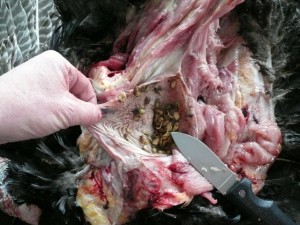 I remember an esteemed scientist stating at a conference many years ago “the best way to improve genetics is nutrition, nutrition, nutrition.” I would redefine that a bit and say there is no way to improve genetics of free-ranging wildlife. However, by significantly increasing the amount of high quality forage and grain available for consumption you can improve the body and antler size and the number of fawns recruited for free-ranging wildlife.
I remember an esteemed scientist stating at a conference many years ago “the best way to improve genetics is nutrition, nutrition, nutrition.” I would redefine that a bit and say there is no way to improve genetics of free-ranging wildlife. However, by significantly increasing the amount of high quality forage and grain available for consumption you can improve the body and antler size and the number of fawns recruited for free-ranging wildlife.
The Proving Grounds is in an area dominated by high-graded timber and fescue pasture. There are no production corn or soybean crops nearby. However, the wildlife we produce and harvest have similar body weights and antler size as critters in ag production areas. We’ve taken no steps to alter the genetics of our herds and flocks. We have grown quality grain and forage for their consumption. My neighbors probably think “the deer at The Proving Grounds have good genetics.” The local deer herd shares the same genetics. However, the deer at The Proving Grounds can express their genetic potential because of the quality forage and grain crops. Brad and I just returned from working on our no-till drill. To some, we were working on improving the genetics of the local deer and turkey populations.
Growing Deer together,
Grant
Learning from Harvested Critters!
Unless you manage land in an area where the primary land use is commercial ag production, it requires good food plots to produce forage and grain on a year round basis. The corn and soybean rotation in areas where the primary land use is commercial ag production provides a great diet for deer, turkey, and many other wild species. Even though these crops are harvested, the combines spill a bit of grain that provides high quality food through the winter.
However, as combines become more efficient, there is less and less spilled grain available for wildlife. This is why it’s important to plant specifically for wildlife in both areas with and without commercial ag production.
There have been four turkeys harvested so far during 2011 at The Proving Grounds. I checked the crop in three of these turkeys and each of them contained soybean grain! The last was yesterday when my 80 year old father harvested an adult gobbler. It was a thrilling hunt and the real trophy was the time spent with my father. The gobbler and video was a bonus. However, I always want to learn from the harvested critter as much as practical. I call this scouting from the skinning shed!
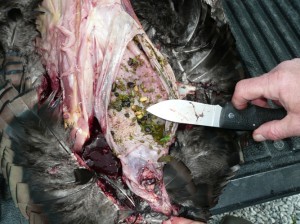
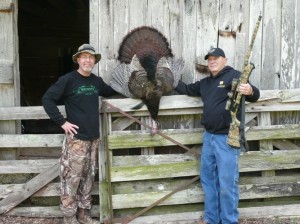
This goes beyond recording weight, spur length, and beard length. One of the most important sources of information from all harvested critters is what’s in their gut (or crop when talking about turkeys). Even though it’s late April and we’ll begin planting Eagle Seed soybeans soon, this turkey had soybeans in its crop. My father harvested this gobbler just after noon, so the crop wasn’t full (he had probably been chasing hens all morning) but it still contained soybeans.
Truly the Eagle Seed beans planted during April and May 2010 are still feeding wildlife at The Proving Grounds a year later. That’s an extreme value! Scouting from the skinning shed also provides me with more confidence on where I should take Tracy, my wife, hunting later this week.
The next time you harvest a critter don’t pass on the opportunity to learn about the local habitat and current hunting information. Sometimes the best scouting occurs without leaving the skinning shed.
Growing Deer together,
Grant
Year Round Food Plots: The Magic Bean!
I was part of a panel at a national convention years ago when a member of the audience asked each member of the panel what they thought was the “magic bean” for food plots. Each member of the panel except me offered a suggestion like clover, brassicas, peas, etc. I refused to answer. I agreed with my colleagues that each of the crops they mentioned had good characteristics, but each also had obvious limitations.
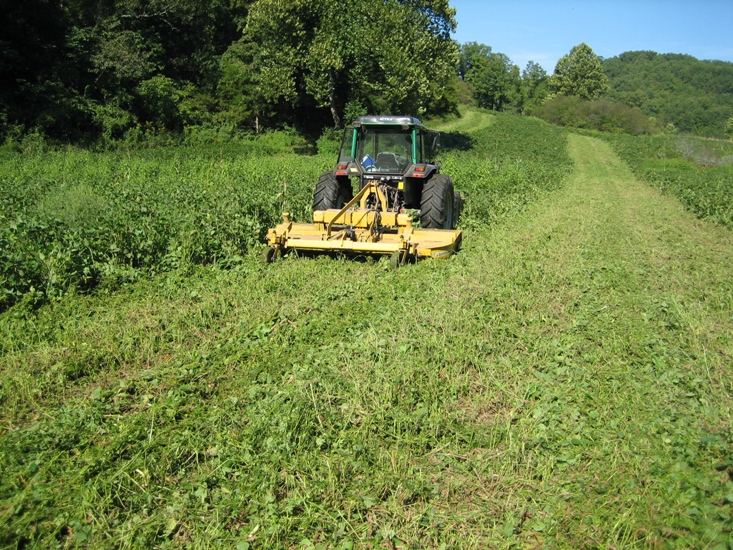 In the decade or so that has passed since that conference I’ve designed, established, maintained and/or evaluated literally 1,000’s of acres of food plots planted in dozens of different crops. Some of those crops proved to be totally unused by deer or the preferred species of game (hence a weed for the food plot mission) or their ability to produce substantial high quality forage was limited, or limited to a very small geographic area.
In the decade or so that has passed since that conference I’ve designed, established, maintained and/or evaluated literally 1,000’s of acres of food plots planted in dozens of different crops. Some of those crops proved to be totally unused by deer or the preferred species of game (hence a weed for the food plot mission) or their ability to produce substantial high quality forage was limited, or limited to a very small geographic area.
During that time I was introduced to forage soybeans. The first plot of forage soybeans I planted was in Mississippi. I remember being amazed at the tonnage of forage. During late August the forage was mowed and I advised the landowner to plant a common winter crop such as wheat. During the next few years I planted or advised more folks to plant forage soybeans as the yield of high quality forage was better than any other crop during the growing season. Years later, I noted that the Eagle Seed forage soybeans were producing a tremendous amount of pods!
A good stand of winter wheat will yield 1,200 to 1,600 pounds of forage per acre. One very poor crop of Eagle Seed forage soybeans (30 bushels per acre) yields 1,800 pounds of high quality grain (soybeans) per acre. I realized that when I mowed the Eagle Seed soybean forage during the early fall, I was mowing down more high quality winter food than what the next crop would likely produce! The beans were already available while I or my clients had to pay for the labor, seed, and fertilizer to gamble to produce another crop.
I’ve now practiced for years a strategy of establishing a high quality crop of forage soybeans and allowing deer and turkey to forage on the vegetation throughout the growing season. Then I leave the crop standing and allow the same critters to consume the seed pods throughout the winter. The crop literally can provide high quality food until it is time to prepare for planting another crop the following spring.
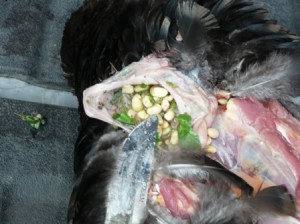
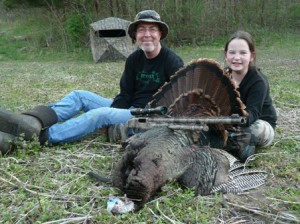 Forage soybeans can produce high quality food for 11 months, from one planting and one expense. I was reminded of the huge advantages of forage soybeans while I was cleaning a gobbler my oldest daughter, Raleigh (age 12), harvested this past weekend. After removing the gobbler’s breast, I opened the crop to see what he had been eating. We call this scouting from the skinning shed. By seeing what critters are currently eating, a hunter can accurately predict where other members of the same species will be consuming the next few days. Raleigh’s turkey was full of soybean seeds! Using this M.R.I. (Most Recent Information), I took my youngest daughter, Rae (age 9) hunting that afternoon. We selected a location overlooking a forage soybean field that had been planted the previous spring. She harvested a mature gobbler there that afternoon.
Forage soybeans can produce high quality food for 11 months, from one planting and one expense. I was reminded of the huge advantages of forage soybeans while I was cleaning a gobbler my oldest daughter, Raleigh (age 12), harvested this past weekend. After removing the gobbler’s breast, I opened the crop to see what he had been eating. We call this scouting from the skinning shed. By seeing what critters are currently eating, a hunter can accurately predict where other members of the same species will be consuming the next few days. Raleigh’s turkey was full of soybean seeds! Using this M.R.I. (Most Recent Information), I took my youngest daughter, Rae (age 9) hunting that afternoon. We selected a location overlooking a forage soybean field that had been planted the previous spring. She harvested a mature gobbler there that afternoon.
By using the technique of scouting from the skinning shed, I was able to confirm that Eagle Seed forage soybeans provide high quality food (forage with high quality protein during the summer and seeds with high quality energy during the winter) at least 11 months throughout the year.
If I was asked the same question at a conference again today, I would have a much better idea of what the “magic bean” is for wildlife food plots. It is a forage soybean that also produces gads of grain.
Growing Deer together,
Grant



